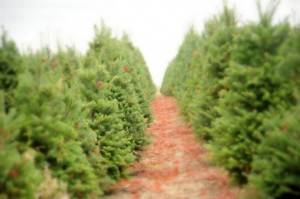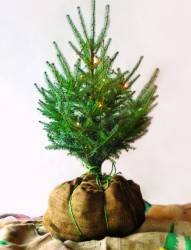After the holidays people throw their real Christmas trees in the garbage. This is common knowledge to just about everyone, but it wasn’t in my purview until last winter, when I moved into a neighborhood where the New Year brought old trees to the end of every driveway.
There is an explanation for my former ignorance, at least where Christmas trees are concerned.
When I was growing up, my family always replanted our Christmas tree in the backyard, and I naively assumed that that was the way everyone with a real tree did it. I just didn’t understand how things usually happened between humans and evergreens, since all my friends and relatives had fake trees that they would re-box and pack away for the rest of the year. But not us. My father hates storing things even more than he hates throwing them away.
 Every year, the drill was the same: A week before Christmas my dad and brother Dewby and I would borrow my uncle’s pick-up truck and drive 20 miles to a nursery that sold Christmas trees. But these weren’t any ordinary trees: These trees still had their roots intact, albeit under cover of a soiled, torture-style, burlap sack. Dewby and I would run around the nursery throwing snow or dirt at one another while our father helped the arborist load our tree into the bed of the truck. Then we would take it home and store it in our garage. There it would live on the arborist’s RDA of straw, tap water (“one quart, no more, no less”), and love.
Every year, the drill was the same: A week before Christmas my dad and brother Dewby and I would borrow my uncle’s pick-up truck and drive 20 miles to a nursery that sold Christmas trees. But these weren’t any ordinary trees: These trees still had their roots intact, albeit under cover of a soiled, torture-style, burlap sack. Dewby and I would run around the nursery throwing snow or dirt at one another while our father helped the arborist load our tree into the bed of the truck. Then we would take it home and store it in our garage. There it would live on the arborist’s RDA of straw, tap water (“one quart, no more, no less”), and love.
On December 23 we would bring the tree into the house and deliver it to its festive resting place: a black, rubber, 15-gallon tub. To keep the tree upright, we bundled old newspapers around the base ― a choice my father settled on after years of using sawdust, which got everywhere and made the house smell like a lumber yard. After the tree was in place, my mother would put a scarlet blanket over the tub, concealing the burlap-rubber monstrosity housed beneath.
 Following all the decoration and celebration and confrontation, on January 2 it was time for the tree to go back to the garage for a transitional period. On the following Saturday, without fail, we would carry the tree to the back yard, where it joined a small group of blue spruce and white pine, Christmas trees-cum-windbreakers from seasons past. My father would dig a hole with his spade, take the burlap off the roots, and we would drop the tree into the ground and fill in the hole, creating a mound of earth around the trunk. And that’s the way we did it every year of my childhood, Mom and Dad and Dewby and I in our hats and gloves, standing between the house and our row of evergreens.
Following all the decoration and celebration and confrontation, on January 2 it was time for the tree to go back to the garage for a transitional period. On the following Saturday, without fail, we would carry the tree to the back yard, where it joined a small group of blue spruce and white pine, Christmas trees-cum-windbreakers from seasons past. My father would dig a hole with his spade, take the burlap off the roots, and we would drop the tree into the ground and fill in the hole, creating a mound of earth around the trunk. And that’s the way we did it every year of my childhood, Mom and Dad and Dewby and I in our hats and gloves, standing between the house and our row of evergreens.
At the time I valued our annual Christmas tree tradition as a symbolic way to add beauty to our backyard. Today I view it in another light: as a greener alternative to fresh cut trees and plastic replicas. Unlike fake trees, live trees smell magnificent and add character to one’s living space. But more importantly, you can repurpose them after the holidays by returning them to the earth, whether you have a large yard or no yard at all (in which case, you could donate your tree to a local park, or to your city, county, or state). So this holiday season, if your budget and housing arrangement make it feasible, consider buying a living tree for your living room.
Living, rooted trees are now available at several area nurseries, including Tucker’s Tree Farm (234-2917), near Mattoon; Four E’s Trees (864-4704) and Greentree Christmas Tree Farm (423-1558), in Decatur; and Bomke’s Patch (626-1636), in Springfield.
Image of tree farm from inhabitat.com.
Second image from www.downeast.com.








